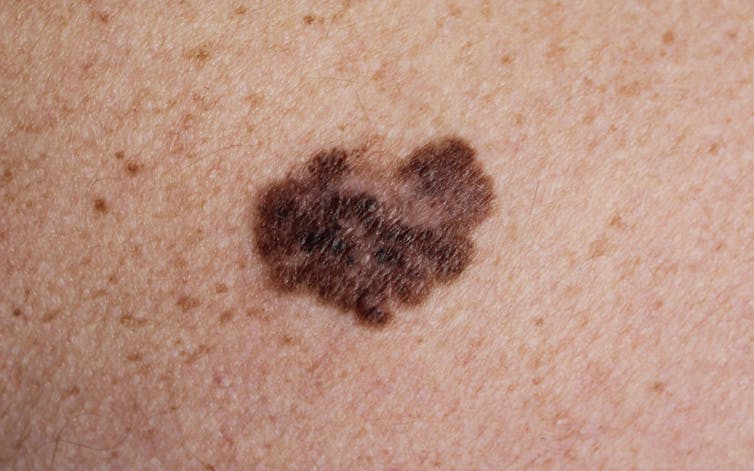If you mention skin cancer, most people think of melanoma – the deadliest skin cancer. The other ones are pretty benign, right?
Not so. Worldwide, more people are now dying of non-melanoma skin cancer (NMSC) than melanoma, a new study has found.
The study, by researchers at the University Hospital of Nice in France, used patient data collected by the International Agency for Research on Cancer (part of the World Health Organization). It showed that while melanoma caused 57,000 deaths globally in 2020, non-melanoma skin cancer accounted for even more, with 63,700 people losing their lives.
In some ways, the study upends conventional wisdom on how much of a threat to life NMSC represents. NMSC is considered to be less serious than other types of cancer – rarely fatal and often left out of national cancer registries’ reports of overall cancer numbers. However, “rarely fatal” is not the same as “never fatal”, and if a sufficiently large number of people develop this type of cancer, then that can add up to a lot of deaths, as this new report shows.
Melanoma and NMSC share some features, with both being closely linked to exposure to ultraviolet radiation (UV) from either the sun or tanning beds. UV is able to produce cancer-causing mutations that drive the formation of both melanoma and NMSC.
The past several decades have seen large increases in the incidence of both types of cancer, as people’s holiday destinations and attitudes to tanning have changed. Most of these cancers occur in white people, but people with darker skin tones can also get skin cancer. Unfortunately, it often goes undiagnosed due to a lack of awareness in both patients and dermatologists.
Melanoma and NMSC do have some important differences, though. While UV is a risk factor for both, NMSC is more associated with chronic exposure throughout a person’s lifetime. Consequently, tumours often arise on the face and head. In contrast, occasional severe sunburns are more closely linked to melanoma, particularly on the trunk.
There are two main types of NMSC: basal cell carcinoma (BCC) and squamous cell carcinoma (SCC). Both arise from a type of skin cell called a keratinocyte.
Keratinocytes are the main type of cells that make up the epidermis, the outer layer of our skin. Mutations in keratinocytes, caused for example by exposure to UV, can override the internal checks and balances that usually prevent cells from uncontrollably dividing, resulting in a tumour forming.
In contrast, melanomas occur as a consequence of cancer-activating mutations in a different type of skin cell called a melanocyte. There are about ten times fewer melanocytes than keratinocytes in the epidermis, but they play an important role in protecting our skin from damage by producing melanin. Melanin is the pigment that determines our normal skin colour and which is produced in greater amounts after exposure to UV, causing a tan.

Melanoma is caused by mutations in skin cells called melanocytes. Nasekomoe/Shutterstock
How deaths occur
Most cancer deaths are caused by secondary tumours that arise when cells from the original tumour break away and spread, or metastasise, to distant sites in the body. Skin cancers are no exception. However, metastasis is a very challenging process for cancer cells. They first need to invade surrounding tissue, then survive the stress of transport around the bloodstream before finally being able to establish a colony in an environment that is quite different to the skin.
Melanoma cells are much more effective at achieving all of the steps of metastasis than NMSC cells are. For example, melanoma cells share some characteristics with cells found in the brain and so can readily adapt to the brain as a new environment, forming secondary tumours there.
If it’s the case that NMSC is far less likely to form dangerous secondary tumours, then why is it that it causes more deaths than melanoma? This partly comes down to the numbers involved.
While we have a pretty good idea of how many people across the world get melanoma each year, the numbers for NMSC are much less clear. However, we do know that the current official statistic of 1.2 million cases per year (compared to 325,000 for melanoma) is likely to be a substantial underestimate. This is because of inconsistencies in how data on NMSC cases are gathered and reported between different countries.
These gaps in the data mean that it is quite difficult to get a full picture of trends in the number of cases of NMSC and how likely they are to cause death. Despite this gap, a particularly worrying part of this latest report is its conclusion that where you live in the world has a big impact on how likely you are to survive an NMSC diagnosis.
Like all cancers, the earlier a NMSC can be diagnosed and treated, the better the chance of a positive outcome. It remains to be determined whether a tendency to regard NMSC as relatively innocuous has played any role in this trend, or whether it’s entirely due to other factors such as having ready access to diagnosis and treatment.
An optimistic view
Another, more optimistic, reason for NMSC overtaking melanoma as a cause of cancer death may be the significant progress made in treating melanoma over the past few years.
For example, after decades of increases in the annual number of melanoma deaths, the UK has recently turned a corner and fewer people are now dying, despite the number of cases continuing to rise. This trend is thanks to the availability of a range of new targeted treatments for melanoma that are saving lives every day.
However, prevention is always better than treatment and it’s clear that more still needs to be done to prevent these cancers from occurring in the first place. This can be achieved by ensuring that sun protection messages reach everyone at risk.



 FDA Names Tracy Beth Høeg as Acting CDER Director After Richard Pazdur Announces Retirement
FDA Names Tracy Beth Høeg as Acting CDER Director After Richard Pazdur Announces Retirement  Novo Nordisk and Eli Lilly Lower Prices for Weight-Loss Drugs Amid U.S. Agreement
Novo Nordisk and Eli Lilly Lower Prices for Weight-Loss Drugs Amid U.S. Agreement  Eli Lilly Becomes First Pharma Giant to Hit $1 Trillion Amid Soaring Weight-Loss Drug Demand
Eli Lilly Becomes First Pharma Giant to Hit $1 Trillion Amid Soaring Weight-Loss Drug Demand  Eli Lilly’s Weight-Loss Pill Nears Fast-Track FDA Approval as Profits Surge on Global Demand
Eli Lilly’s Weight-Loss Pill Nears Fast-Track FDA Approval as Profits Surge on Global Demand  Novo Nordisk Appoints Greg Miley as Global Head of Corporate Affairs Amid U.S. Pricing Pressure
Novo Nordisk Appoints Greg Miley as Global Head of Corporate Affairs Amid U.S. Pricing Pressure  Pfizer Secures $10 Billion Deal for Obesity Drug Developer Metsera, Outbids Novo Nordisk
Pfizer Secures $10 Billion Deal for Obesity Drug Developer Metsera, Outbids Novo Nordisk  Trump Signs Executive Order to Boost AI Research in Childhood Cancer
Trump Signs Executive Order to Boost AI Research in Childhood Cancer  Merck Nears Acquisition of Cidara Therapeutics at Significant Premium
Merck Nears Acquisition of Cidara Therapeutics at Significant Premium  Trump and Merck KGaA Partner to Slash IVF Drug Costs and Expand Fertility Coverage
Trump and Merck KGaA Partner to Slash IVF Drug Costs and Expand Fertility Coverage  Pfizer Sues Novo Nordisk Over Alleged Tactics to Block Obesity Drug Competition
Pfizer Sues Novo Nordisk Over Alleged Tactics to Block Obesity Drug Competition  Trump Hints at Major Autism Announcement, Raises Questions on Tylenol Link
Trump Hints at Major Autism Announcement, Raises Questions on Tylenol Link  Canada Loses Measles-Free Status After Nearly 30 Years Amid Declining Vaccination Rates
Canada Loses Measles-Free Status After Nearly 30 Years Amid Declining Vaccination Rates  Eli Lilly’s Inluriyo Gains FDA Approval for Advanced Breast Cancer Treatment
Eli Lilly’s Inluriyo Gains FDA Approval for Advanced Breast Cancer Treatment  Novartis to Acquire Avidity Biosciences for $12 Billion to Strengthen Rare Muscle Disorder Portfolio
Novartis to Acquire Avidity Biosciences for $12 Billion to Strengthen Rare Muscle Disorder Portfolio 




























